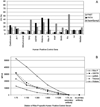Evaluation of microarray surfaces and arraying parameters for autoantibody profiling
- PMID: 18752214
- PMCID: PMC3335271
- DOI: 10.1002/pmic.200800146
Evaluation of microarray surfaces and arraying parameters for autoantibody profiling
Abstract
Autoantigen microarrays are being used increasingly to study autoimmunity. Significant variation has been observed when comparing microarray surfaces, printing methods, and probing conditions. In the present study, 24 surfaces and several arraying parameters were analyzed using >500 feature autoantigen microarrays printed with quill pins. A small subset of slides, including FAST, PATH, and SuperEpoxy2, performed well while maintaining the sensitivity and specificity of autoantigen microarrays previously demonstrated by our laboratory. By optimizing the major variables in our autoantigen microarray platform, subtle differences in serum samples can be identified that will shed light on disease pathogenesis.
Conflict of interest statement
Conflict of interest statement: In the past 3 years P. J. U. has served as a consultant to Centocor (Horsham, PA), Biogen/Idec (Cambridge, MA), Avanir, Inc (La Jolla, CA), Astra Zeneca (London, UK), and Genentech (South San Francisco, CA). He is a member of the Scientific Advisory Board of Monogram Biosciences (South San Francisco, CA) and XDx (South San Francisco), and a cofounder and consultant at Bayhill Therapeutics (Palo Alto, CA). I. B., C. L., and J. D. T. have declared no conflict of interest.
Figures


References
-
- Balboni I, Chan SM, Kattah M, Tenenbaum JD, et al. Multiplexed protein array platforms for analysis of autoimmune diseases. Annu. Rev. Immunol. 2006;24:391–418. - PubMed
-
- Robinson WH, DiGennaro C, Hueber W, Haab BB, et al. Autoantigen microarrays for multiplex characterization of autoantibody responses. Nat. Med. 2002;8:295–301. - PubMed
-
- Feng Y, Ke X, Ma R, Chen Y, et al. Parallel detection of autoantibodies with microarrays in rheumatoid diseases. Clin. Chem. 2004;50:416–422. - PubMed
Publication types
MeSH terms
Substances
Grants and funding
LinkOut - more resources
Full Text Sources
Medical
Molecular Biology Databases

